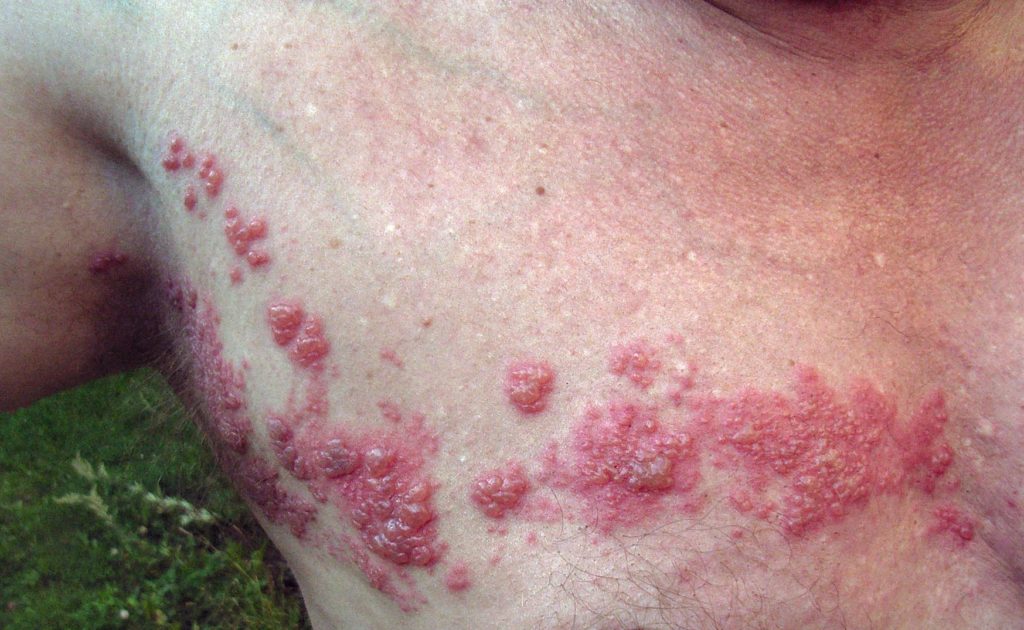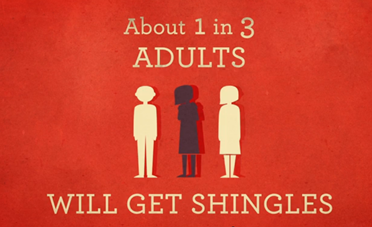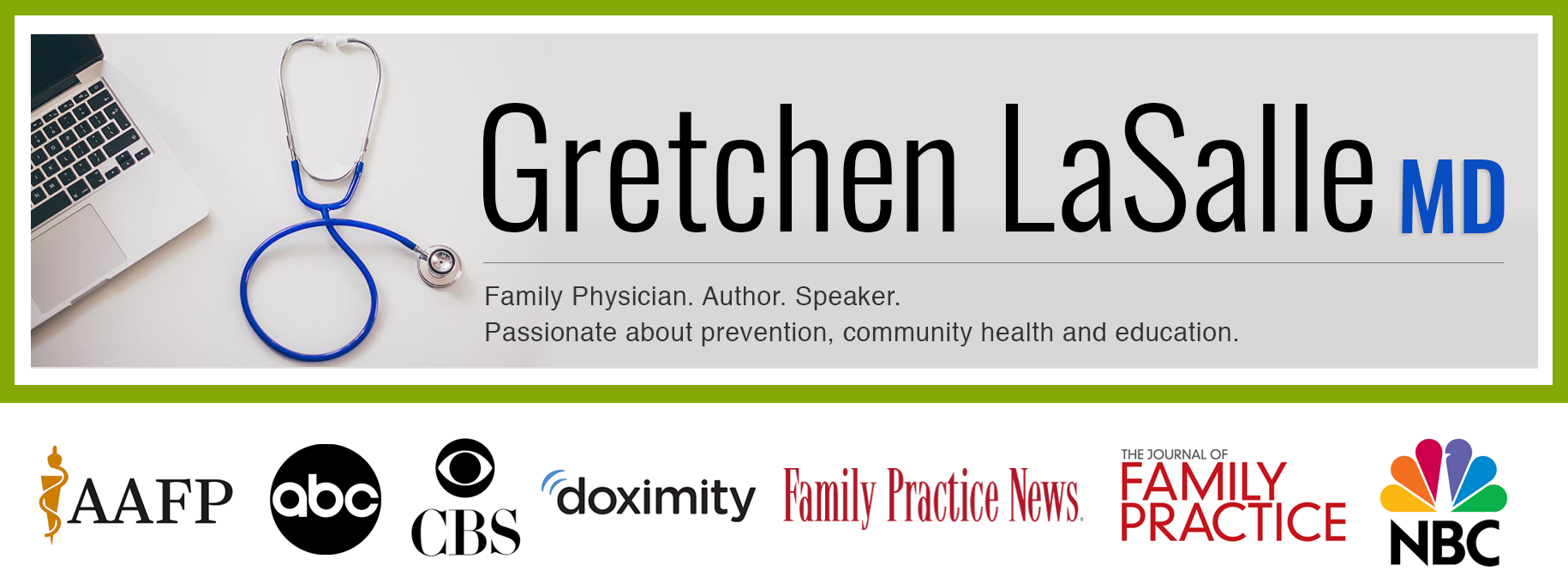As a family physician, I not only have the pleasure of discussing vaccines with my parents of young children and teens but I also get to walk my adult patients through their ongoing need for immunizations as well. Almost all adults need the following (check with your primary provider for individualized recommendations):
- a yearly flu shot
- a tetanus (Tdap or Td) vaccine every 10 years
- pneumonia vaccines (PCV13 and pneumococcal 23, one each after the age of 65)**
- and the shingles vaccine
I have discussed the flu vaccine in detail here. Future blogposts will undoubtedly touch on specifics of the others as well. But today, folks, we are talking about shingles and the shingles vaccine.
Maybe it’s because many people have either had or known someone who’s had shingles – and therefore know the horrific pain that shingles can cause. Or maybe it’s because the most recent shingles vaccine (called Shingrix) is so dang hard to come by. Whatever the reason, shingles vaccination is a popular topic in my clinic these days. Let’s lay out some facts about shingles.
What is Shingles?
Shingles is a reactivation of the chicken pox (or varicella zoster) virus that lies dormant, or sleeping, in the body’s nerves after an infection. It is a member of the herpes virus family so you may also see it referred to as herpes zoster.
Shingles most often occurs during periods of stress or illness, when the body’s defenses are down. And this occurs more commonly as we age. It causes a painful, blistering rash along a nerve root (see below) and any nerve root can be affected. Sometimes it shows itself on the chest, as seen here, or abdomen; sometimes down an arm or leg, and sometimes in the head and neck area where, if affecting the eye, it can threaten a person’s vision. Because it occurs in a nerve root, it only affects one side of the body.

It often begins with prodromal (or early warning) symptoms. These can range from itching to tingling to a burning sensation along the distribution of the nerve. These symptoms occur several days before the classic rash appears. Often times, people will also have low grade malaise or fatigue in the early stages of the illness.
Then… the rash begins. It appears as clusters of blisters on an angry red base. This can range in severity from just a few isolated blisters to a rash extending along the entire length of the nerve root, as seen in the picture above.
The pain associated with the shingles rash is a searing, burning, unrelenting nerve pain. The rash typically lasts up to several weeks but the pain can last much longer.

Postherpetic Neuralgia – a dreaded outcome
The most dreaded consequence of a shingles outbreak is a condition called postherpetic (meaning, following a herpes zoster outbreak) neuralgia (or, nerve pain), and it can last for years. Postherpetic neuralgia (PHN) is a devastating chronic pain syndrome that significantly adversely affects daily living. We vaccinate largely to prevent this outcome of the illness.
One in three people (that’s a lot!) will develop shingles in their lifetime. Of those over 50 affected by shingles, 10-13% will develop postherpetic neuralgia.
What happens if I get shingles? Am I contagious? What do I do about the pain?
Contagion: No, you don’t have to isolate yourself from the world. It turns out that shingles is only contagious if someone who has never had chicken pox, or who is immune compromised, touches the fluid in the blisters. So as long as you are keeping that rash covered and washing your hands frequently, you are at very low risk of passing the chicken pox virus to others.
Treatments: Thankfully, there are anti-viral medications that, if started early enough in the course of the illness, can shorten the duration of the rash and decrease the chances of PHN. There also exist non-habit forming medications (both oral and topical options) that can treat that nervy character of the pain.
But what’s better than treating an illness? Well, if you’ve been following my blog, you might know the answer. Prevention, of course! And what helps prevent vaccine-preventable diseases? You guessed it. Vaccines!

What are these shingles vaccines you speak of?
There are currently two vaccines, Zostavax and Shingrix, available to prevent shingles. We will spend the majority of our time on Shingrix as it is MUCH more effective than Zostavax for the prevention of shingles.
However, Zostavax is still out there and can be used if Shingrix is not available. So, here are a few notes on Zostavax.
Zostavax:
- It is approved for use after the age of 50 but is often not covered by insurance until the age of 60.
- It is a live-attenuated (weakened) form of the virus. As a result, it should not be used in persons with compromised immune systems (people on chemotherapy, patients without a spleen, patients on high doses of steroids, etc.). If used in these groups, it could cause shingles.
- It is only about 45-50% effective. However, if a person were to get shingles despite having had the Zostavax vaccine, it would at least be a less severe case.
For many years, Zostavax was the only prevention we had. But that all changed in 2018 when Shingrix became available. Thank you, vaccine researchers!
Shingrix:
- Before release to market, Shingrix was studied in a multi-center trial involving 18 countries. Researchers enrolled over 30,000 participants and tested the vaccine against saline placebo (for those folks out there who claim vaccines are never tested against placebo).
- Shingrix is recommended for anyone age 50 and older.
- It is a killed virus vaccine. This vaccine cannot give you shingles and it is generally considered safe in people with compromised immune systems. Caveat… it was not studied in people with compromised immune systems so there are currently no recommendations for or against use in this population. If you are immune compromised, you should talk to the doctor managing that illness (Rheumatology, Oncology, etc.) to seek their recommendation.
- Shingrix is >90% effective in preventing shingles, with similar efficacy in preventing postherpetic neuralgia.
- Shingrix is safely co-administered with other vaccines.
- The Shingrix vaccine is actually a 2-dose series. After the first dose you need to return 2-6 months later to get the 2nd dose to achieve full immunity.
That all sounds amazing. But what’s the down side?
Well, mostly it is amazing. The biggest problem we are facing is with vaccine supply. The manufacturer (GlaxoSmithKline) vastly underestimated the popularity of the Shingrix vaccine when it released it to market in 2018. It is currently very difficult to find. Your doctor’s office may receive it intermittently. The pharmacies are also getting vaccine here and there. You can check here to locate pharmacies that may carry the vaccine. It takes about 6-9 months to manufacture the vaccine so we are just in a holding pattern while GSK produces more.
Other things to know about in relation to this vaccine…
- If you have to pay out of pocket, it costs around 300$ for the two shots. You may want to check with your insurance company to see if it’s covered.
- About 1 in 6 people are having a more significant reaction to the vaccine – redness and swelling at the injection site, low grade fever, body aches, etc. These symptoms last about 2-3 days and then resolve. They are not dangerous but are annoying and uncomfortable. So, you may not want to get the vaccine right before leaving on that European vacation you’ve been planning for 2 years.
Now that we know the basics, let’s cover some more in-depth questions about shingles and the shingles vaccine.
Shingles and the shingles vaccine Q&A
- Why would someone get Zostavax now that we have Shingrix?
• Given that Shingrix is so hard to find, someone who is about to embark on a journey of immune suppression (anticipating starting chemotherapy, for example) may still want to get protection from shingles by getting Zostavax if Shingrix is not available. - I’ve had shingles. Doesn’t that mean that I can’t get it again?
• Unfortunately, no. Think of this virus as similar to the one that causes cold sores. Many of us have had cold sores and know how often they can recur. Shingles behaves similarly. It is possible to get it over and over again. - I just had shingles and I never want that to happen again! When can I get the shingles vaccine?
• The answer is different depending on which vaccine we are talking about.
• Zostavax – you have to wait at least 6 months after a shingles outbreak to get this vaccine.
• Shingrix – the vaccine can be given as soon as the rash crusts or scabs over. - I’m on antiviral medication for recurrent herpes outbreaks. Can I get the shingles vaccine?
• Antiviral medication would decrease our immune response to the shingles vaccine.
• A person should avoid using antiviral medication for at least 24 hours before vaccination and for 14 days after. - I had Zostavax recently but now Shingrix is available. How soon can I get Shingrix?
• The Centers for Disease Control recommends waiting eight weeks after the Zostavax vaccine before getting Shingrix. - I don’t remember having chicken pox. Should I still get the shingles vaccine?
• Studies show that more than 99% of people over the age of 40 have had chicken pox, whether they remember it or not.
• Yes, you should get the shingles vaccine. - If I know I’m not immune to chicken pox because I had my titers tested, can we just use the shingles vaccine to protect me?
• No. If you test non-immune to chicken pox, you need the chicken pox vaccine. - If a person gets the chicken pox vaccine, are they still at risk for shingles?
• This is a great question! But it is one that we don’t entirely have an answer for… yet.
• The chicken pox vaccine is a weakened form of the chicken pox virus. The question is, does this virus-strain live on in the nerves just like wild-strain chicken pox? Will our vaccinated children still be at risk for shingles when they get older?
• Time will tell. The chicken pox vaccine was introduced in the US in 1995. It is given at ages 12-15 months and again at 4-6 years of age. So, kids who began vaccination in 1995 would have completed vaccination around 2000. The rate of shingles begins climbing after age 50 (though it is possible to get it at earlier ages). We will have to wait until at least around 2045 to start seeing whether vaccinated kids have a decreased chance of developing shingles compared to those who acquired chicken pox naturally. -
-
Well, there you have it. Everything I know about shingles and the shingles vaccines poured out onto the page. If you are 50 or over, I highly recommend you get the Shingrix vaccine when it becomes available. Give me a few years and I will happily be lining up to join you!
** There are multiple cases in which the pneumonia vaccines may be given early or on an alternate schedule. Check with your primary provider to see if early vaccination or an alternate schedule might be right for you.
Resources:
- https://www.cdc.gov/shingles/index.html
- https://www.cdc.gov/mmwr/volumes/67/wr/mm6703a5.htm


Thank you for your informative post. As a person with post-herpetic neuralgia I’d hope the vaccine supply issues are resolved and people can prevent this complication.
Hi Heather,
Thanks for your note. I’m sorry you are suffering and I, too, hope this vaccine shortage will end soon. It’s so frustrating to recommend a vaccine but then not be able to give it. I encourage patients to keep checking back in clinic and to call around to different pharmacies. It is out there, it just takes some work to find it!
Fantastically thorough post- everything one would need to know about shingles and vaccine. Will save this for reference!